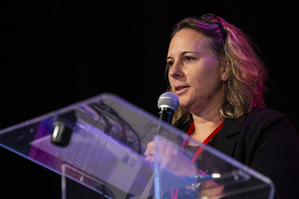Tool development for assessing antineoplastic drugs surface contamination in healthcare services and other workplaces
23 October 2019
Atgé B1,2,3, Dhersin A1,2, Da Silva Caçao O1,2 Martinez B1, Ducint D1, Verdun-Esquer C2,4, Baldi I2,4, Molimard M1, Villa A5, Canal-Raffin M1,2,41 Laboratoire de Pharmacologie Clinique et de Toxicologie, CHU Bordeaux, France
2 INSERM U1219, équipe EPICENE, Université de Bordeaux, France
3 AHI33, Service de Santé au Travail, Bordeaux, France
4 Service de Santé Travail Environnement, CHU de Bordeaux, France
5 Consultation de Pathologie Professionnelle, Hôpital la Timone (AP-HM), Marseille, France

Context–objective
Healthcare workers exposure to antineoplastic drugs is a burning issue for occupational medicine practitioners. Biological monitoring of occupational exposure (BMOE) is an essential tool for assessing antineoplastic drugs contamination of healthcare workers. In addition to BMOE, surface sampling is a useful tool in order to understand how workers get contaminated, to identify sources of environmental contamination, to verify the effectiveness of surface decontamination way and to insure a monitoring of these surfaces. The objective of this work was to develop a complete tool including a kit for surface sampling and a quantification analytical method for antineoplastic drugs traces detection. The development was realized with the three following criteria: kit capacity to sample in every professional environment (healthcare services, veterinaries…), detection of very low antineoplastic drugs traces with a validated analytical method and the easiness of sampling kit use regardless of person in charge of sampling.
Method
Antineoplastic drugs mostly used in term of quantity and frequency, have been identified by an analysis of literature and consumptions of different hospitals, veterinary services and home care settings. The kind of adsorbent device, surface moistening solution and mix of solvents for extraction of antineoplastic drugs from the adsorbent device have been tested for a maximal yield. Antineoplastic drugs quantification was achieved by an ultra high performance liquid chromatography method coupled with tandem mass spectrometry (UHPLC-MS/MS).
Results
Based on their high frequencies of use and their good reflect of the diverse activities through healthcare services, 15 antineoplastic drugs (cyclophosphamide, ifosfamide, doxorubicin, daunorubicin, epirubicin, 5-FU, dacarbazin, etoposide, pemetrexed, vincristine, cytarabine, methothrexate, paclitaxel, gemcitabine, mitomycin C) were selected. The analytical method was optimized and adapted to obtain high sensitivity with very low limits of quantification (25 to 5 000ng/L), equivalent or lowest that those previously published (for 13/15 antineoplastic drugs). The sampling kit is easy to use, provided with a didactic support. It showed its effectiveness without inter-individual variation (n= 5/person; n= 5 persons; p=0.85; anova) regardless of the person in charge of sampling.
Discussion-Conclusion
This validated tool (sampling kit + analytical method) is very sensitive, easy to use and very didactic in order to control the chemical risk brought by antineoplastic drugs. Moreover BMOE, it permits a focal prevention. Used in routine, this tool is available for every intervention of occupational health.